
The Clifton Suspension Bridge is a suspension bridge spanning the Avon Gorge and the River Avon, linking Clifton in Bristol to Leigh Woods in North Somerset. Since opening in 1864, it has been a toll bridge, the income from which provides funds for its maintenance. The bridge is built to a design by William Henry Barlow and John Hawkshaw, based on an earlier design by Isambard Kingdom Brunel. It is a Grade I listed building and forms part of the B3129 road.
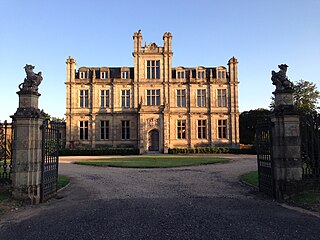
Bylaugh Hall, also known as Bylaugh Park, is a country house situated in the parish of Bylaugh in Norfolk, England.
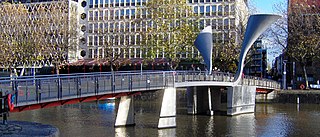
Pero's Bridge is a pedestrian bascule bridge that spans St Augustine's Reach in Bristol Harbour, Bristol, England. It links Queen Square and Millennium Square.

The Georgian House is a historic building at 7 Great George Street, Bristol, England. It was originally built around 1790 for John Pinney, a wealthy sugar merchant and slave plantation owner, and is now furnished and displayed as a typical late 18th century town house. The period house museum includes a drawing room, eating room, study, kitchen, laundry and housekeeper's room. There is also a small display on slavery and sugar plantations. The Georgian House has been a branch of Bristol City Council since it was presented to the city as a museum in 1937.
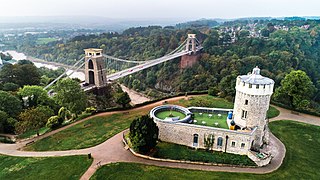
Clifton Observatory is a former mill, now used as an observatory, located on Clifton Down, close to the Clifton Suspension Bridge, Bristol, England.

Hodsock Priory is an English country house in Hodsock, Nottinghamshire, 4 miles (6.4 km) north of Worksop, England, and 1 mile (1.6 km) south of Blyth. Despite its name, it is not and never has been a priory. Hodsock is renowned for its snowdrops in early spring. It is also a venue for special events and weddings.
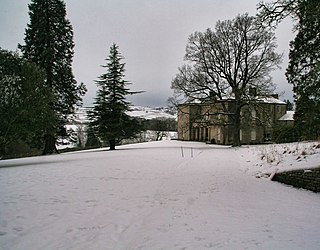
Eggleston Hall is a privately owned 19th-century English country house in Eggleston, Teesdale, County Durham. It is a Grade II* listed building.

Pennyhill Park Hotel is a 19th-century country house hotel and spa in Bagshot, Surrey in the south east of England.

Debden House is a conference centre and campsite located in Loughton, Essex, England. The house is owned and operated by Newham London Borough Council.

John Pretor Pinney was a plantation owner on the island of Nevis in the West Indies and was a sugar merchant in Bristol. He made his fortune from England’s demand for sugar. His Bristol residence is now the city's Georgian House Museum.

Colonel Archibald Christie was a British businessman and military officer. He was the first husband of mystery writer Dame Agatha Christie; they married in 1914 and divorced in 1928. They separated in 1927 after a major rift due to his infidelity and obtained a divorce the following year. During that period Agatha wrote some of her most renowned detective novels. Shortly after the divorce, Christie married Nancy Neele, and the couple lived quietly for the rest of their lives. Christie became a successful businessman and was invited to be on the board of directors of several major companies.

Wadhurst Castle is a 19th-century castellated mansion just to the west of the town of Wadhurst, East Sussex, England, in an elevated position overlooking the countryside to the south. It is a grade II listed building.
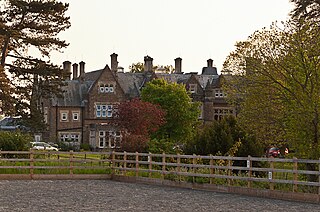
Hartsfield Manor is an early Victorian house of historical significance located in Betchworth, Surrey, England. It was built in the 1860s as a private residence and served this purpose for several notable people until World War II. After this it became a hotel and then a training centre. It is now a venue for special events such as conferences and weddings.

Cotswold Grange Hotel in Cheltenham is a building of historical significance. It was built in about 1840 as a private residence and was home to many notable people over the next century. It is now a hotel which provides accommodation and event services.

The 1831 Bristol riots took place on 29–31 October 1831 and were part of the 1831 reform riots in England. The riots arose after the second Reform Bill was voted down in the House of Lords, stalling efforts at electoral reform. The arrival of the anti-reform judge Charles Wetherell in the city on 29 October led to a protest, which degenerated into a riot. The civic and military authorities were poorly focused and uncoordinated and lost control of the city. Order was restored on the third day by a combination of a posse comitatus of the city's middle-class citizens and military forces.
Charles Pinney was a British merchant and local politician in Bristol, England. He was a partner in a family business that ran sugar plantations in the West Indies and owned a number of slaves. Pinney was selected as mayor of Bristol in 1831 and within weeks had to manage the response to major riots. Public order was lost for a number of days and significant damage caused to the city centre. Pinney was charged with neglect of duty over his actions but was acquitted at trial. He returned to local government as an alderman, holding the position until 1853.

Barton Hall Hotel in Barton Seagrave near Kettering is a building of historical significance and is listed on the English Heritage Register. It was built in about 1550 and was the home of many notable residents over the next five centuries. Today it is a hotel which provides accommodation, restaurant facilities and caters for special events.

Hilton House Hotel, in Derby, England, is a building of historical significance. It is a Georgian house which was the ancestorial home of Herbert Martin Massey. He was the Senior British Officer at Stalag Luft III who authorised the "Great Escape". The hotel closed in February 2023.

Hollybank House near Emsworth in Hampshire, England, is a building of historical significance and is Grade II listed on the English Heritage Register. It was built in about 1825 and was home to many notable residents over the next two centuries. Today it is a Country House B&B and caters for special events including weddings.
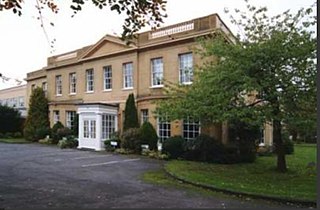
Sindlesham Court, near Wokingham, is a building of historical significance and is Grade II listed on the English Heritage Register. It was built before 1760, as it is shown on Rocque’s Map of 1761. It was the home of several notable residents over the next two centuries. Today it is a venue for weddings, conferences and special events.





















